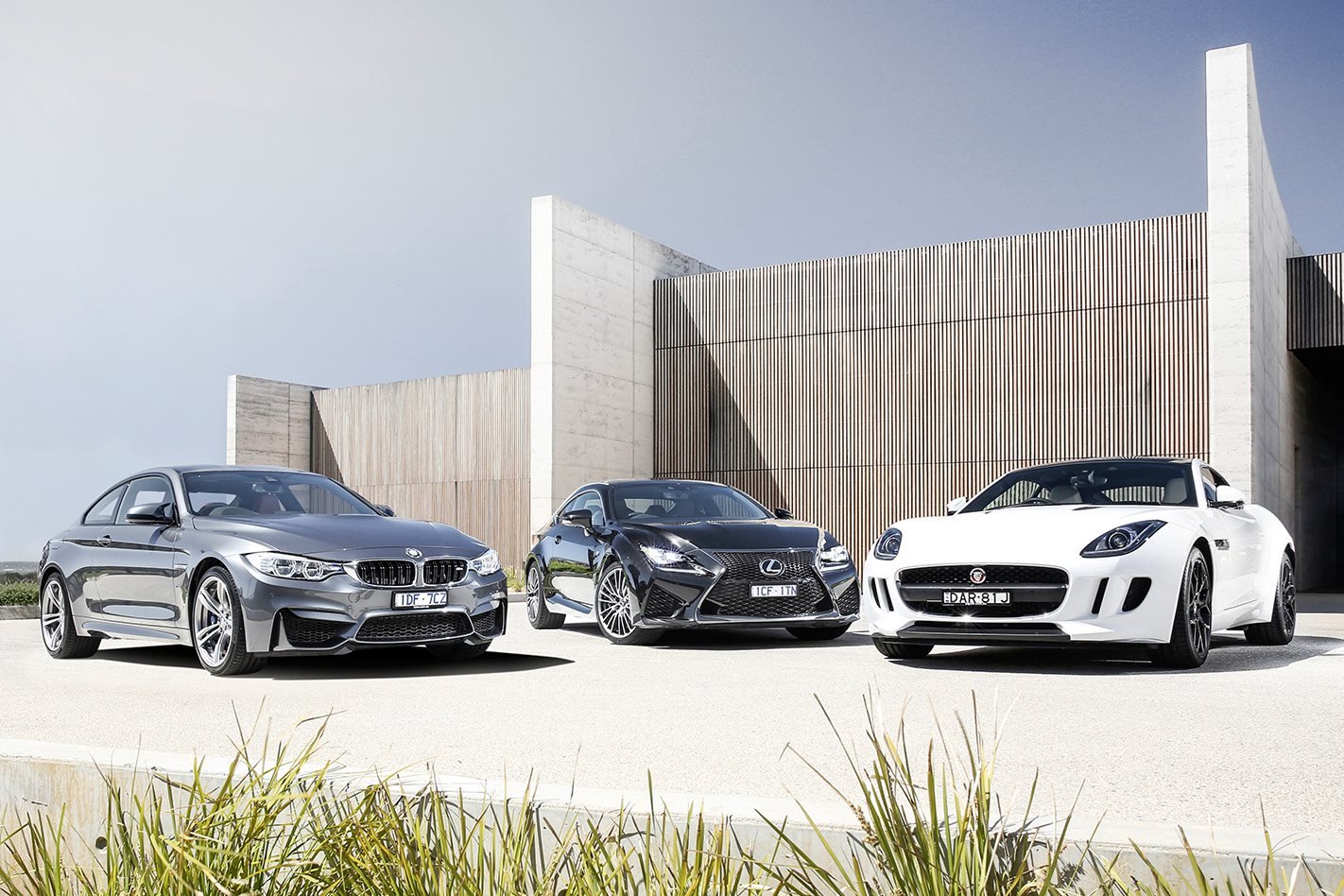See, it’s some kind of wonder that the sports coupé hasn’t, over the years, been honed by successive trends to arrive at a homogenous design that all manufacturers strive to attain.
But when you line these three up, it’s clear that this has never happened. They look different from each other, they’re all powered differently and each one has different strengths and weaknesses. Yet they’re all vying for the same dollar. Clearly, here is proof of the concept that money buys you choices. Either way, there’s a lot to take in here.
Take, for instance, the BMW M4. The hottest 4-Series has been given what BMW calls a life-cycle impulse. That’s facelift to you and me. The big change has been to slice thousands out of the price to avoid the M4 and the new M5 Pure getting their feet tangled on the dance floor. With a 317kW twin-turbo straight six and a seven-speed DCT, the M4 represents a modern approach with that in-line engine as a nod to its past. And the new $149,900 price tag will attract attention.
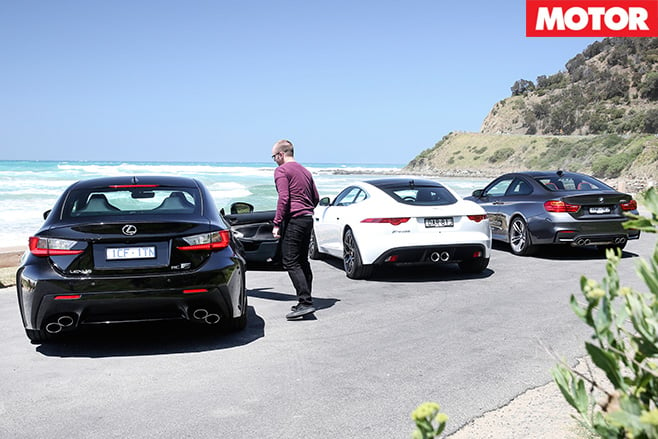
And then there’s the wild card of sorts – the Jaguar F-Type Coupe V6 S. With a supercharged V6 good for 280kW, it’s a few rungs down the horsepower ladder in this trio, and its $151,380 ask – before you add any fruit – doesn’t do it any favours either. It’s also the only one here that is not the top-flight version of its breed, with the supercharged V8 F-Type R casting a big shadow over the V6. Hmm…
While the F-Type might draw on the E-Type for external inspiration, inside it’s a different story. But if it isn’t ye olde worlde drawing room stuff, it’s still nicely executed with everything pretty much where you’d expect it. The electric park brake grates (for me, anyway) and in some ways is even worse than the foot-operated example in the Lexus. Only the BMW gets it right with a conventional hand brake.

The BMW is, in contrast, vastly more complicated. There are three small buttons by the gear selector for the choosing the throttle rate, damper firmness and steering weight. Then there’s another button nearby that controls shift aggression, and all have three settings to choose from.
And then you have a pair of M buttons on the steering wheel, both of which can be configured through the on-board menu system to make a one-touch version of all those other buttons. Seems like doubling up a bit to me, but anyway.

fake carbonfibre trim is equally naff, but at least the M4’s dashboard looks like it was designed in one go. Not so the RC F’s layout, which is more all over the place with different levels and sticky-outy bits for no apparent reason.
The Lexus does, however, have the pick of the chairs with great support and comfort (and they even look good). Not that the others are less than comfy, but the RC F’s seemed to fit me better although the rest of the cabin is a bit tight on headroom with the sunroof fitted.
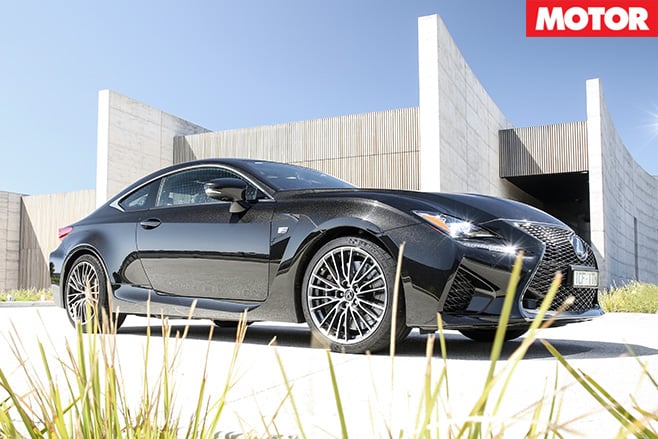
And let’s not forget that the F-Type is the only strictly two-seater here, although the Lexus rear pew is going to be used for soft luggage more often than not. It’s a shame the Jag can’t pull this trick off because luggage space in the Jaguar’s hatch is tiny. Pack light, lovers.
All of which makes the BMW the logical, practical alternative here. Not only is luggage space good, the rear seat is actually useable. It’s a four-seater in the real world, not just in the brochure. Add the fact that the more upright glasshouse makes for a far better view in every direction and you have yourself a sensible sportster. It’s even easier to get in and out of.

Those turbos make it very mid-rangey, and from 80-120km/h takes just 2.37sec. And it’s worth remembering that those numbers were all done without the use of BMW’s launch-control.
Why? Because it’s rubbish, that’s why. Oh, the M4 is not alone in that boat – plenty of other big-power rear-drivers have useless launch systems – but the BeeEm’s is up there with the silliest of them. Even using the cruise control buttons to lower the launch revs makes no difference: The tyres unhook almost immediately and the engine boings into the limiter and sits there.
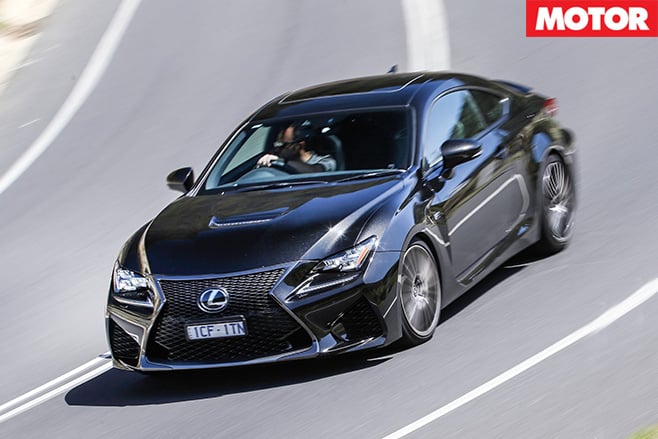
The Lexus was next quickest and a good chunk back with a 13.25sec at 177.8km/h and a 0-100 time of just a tenth over five seconds neat. It also managed to get from 80 to 120km/h in under three seconds. What was a bit surprising was how consistent it was with the traction control turned off. Okay, so it’s an auto, but it ran 13.2, 13.2 and 13.2, time and time again. And when you consider how damn heavy the Lexus is (plenty, trust us) that’s even more impressive.
Based on the kilowatts the Jaguar gives away to the other two, it’s no surprise that it was slower. But the manual gearbox also plays against it on the dragstrip, both in terms of consistency and outright ability, as well as dictating that there’s no launch-control system in the manual F-Type.
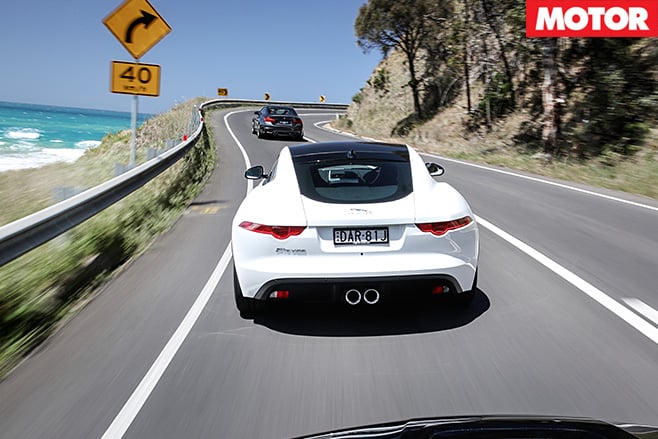
But it wasn’t entirely convincing as a bomb-proof proposition with the clutch feeling like it was suffering a bit. Fast shifts on the strip felt like it had the engine either bogging slightly as you dumped the clutch, but it could also have been the clutch getting hot and bothered and not engaging solidly, allowing the driveline to take a small breather between gears.
What’s also interesting is that away from the hotmix and Christmas tree, the Jag doesn’t feel like it’s giving that much away. Oh sure, it’s never as feisty as the others on the road, but it has plenty up its sleeve for overtaking and hauling along in a tall gear at a moderate speed. Thanks to the fact that a supercharger is on the job from idle, the Jag builds power fairly linearly and simply piles on more as you get higher on the tacho face.

And the BMW? Well, there’s just nowhere on the tacho to hide. The boost builds quickly and from ridiculously low engine speeds to absolutely cannon you out of corners. That turbo rush also gives the BMW an urgency and potency that the others can’t get near. But where the M4 falls down is in the refinement department. Okay, so performance is clearly king in a car like this, but should it be at the expense of so much smoothness?
I’m not entirely sure what’s going on here, but it could be that BMW has tried to engineer some character into the M4’s 3.0-litre straight six. Problem is, it ain’t a smooth, sophisticated character; it has more of a rough-arsed feel that reminds me of the grumpy old pushrod sixes of my yoof.
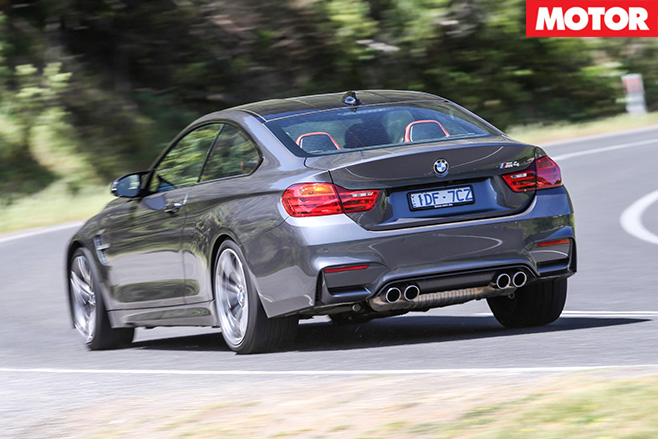
That lack of finesse extends to the chassis and steering, too. The adjustability of the steering affects only the weight, but none of the available settings feel quite right. It’s probably nicest in Comfort as the Sport and Sport Plus settings simply make it more difficult to budge off-centre without actually adding to the accuracy.
Speaking of accuracy, it’s actually pretty good, but it just doesn’t want to talk you much about it. The ride is firm, no question, but left in Comfort mode you will actually get used to it after a short time.
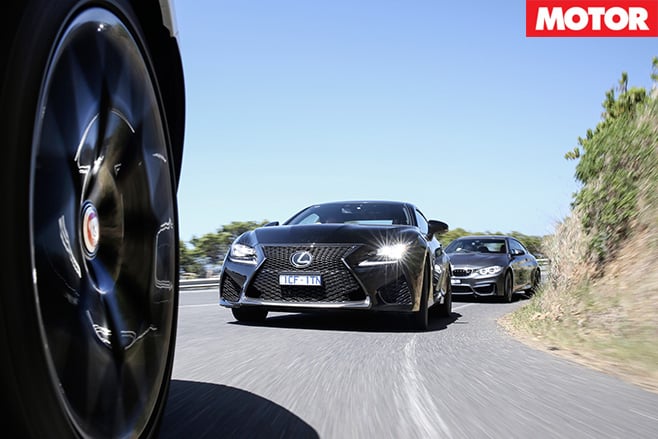
The pay-off there is that the Lexus rides a little better but it still has pretty dead steering feedback. That said, it is probably almost as accurate as the BMW’s tiller. The big downfall is in its transmission, which feels a bit lazy and unpredictable in some situations while the BMW’s DCT is sharp, intelligent and never throws up any surprises in terms of ratio choice.
Being a manual, if the Jag wrong-slots you, it’s your own fault, but it’s worth saying that the shift action is very good and the engine is flexible enough that you can pull sixth at 80km/h happily and without stressing the car. If anything, the steering is just as lethargic at the straight ahead as the others but thanks to the lighter engine, it feels a little better balanced at speed.
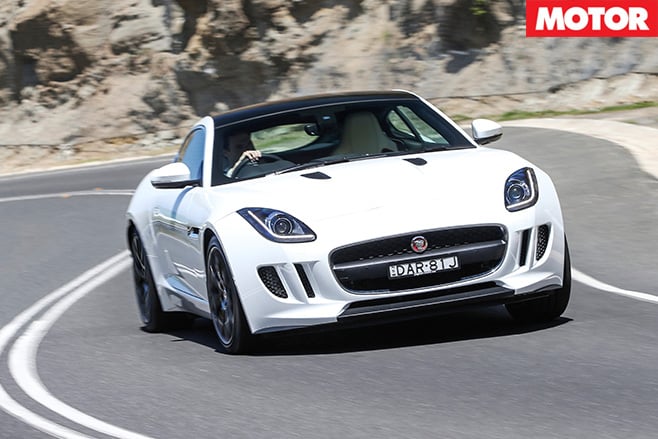
The Lexus RC F is a competent, swift and well-made car but neither finishes first on a cerebral level nor on an emotional one. And that has to mean it only gets to stand on the third step of the podium.
If you approach this with your head, the BMW is an easy winner. It’s faster, grippier, has better brakes and is somehow, despite all that, vastly more practical than the other two. Hell, it’s even better value when you look at the kit it carries.
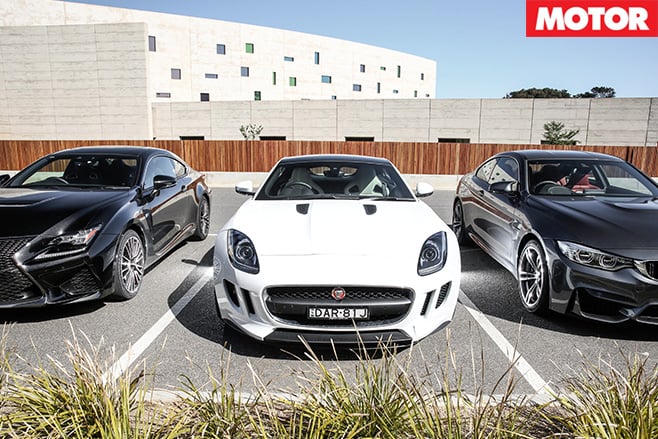
| u00a0 | LEXUS RC F | JAGUAR F-TYPE COUPE V6 S | BMW M4 |
| Body | 2-door, 4-seat coupu00e9 | 2-door, 2-seat coupu00e9 | 2-door, 4-seat coupu00e9 |
| Drive | rear-wheel | rear-wheel | rear-wheel |
| Engine | 4969cc V8, DOHC, 32v | 2995cc V6, DOHC, 24v, supercharged | 2979cc inline-6, DOHC, 24v, twin-turbo |
| Bore/stroke | 94.0 x 89.5mm | 84.9 x 89.0mm | 89.6 x 84.0mm |
| Compression | 12.3:1 | 10.5:1 | 10.2:1 |
| Power | 351kW @ 7100rpm | 280kW @ 6500rpm | 317kW @ 5500-7300rpm |
| Torque | 530Nm @ 4800-5600rpm | 460Nm @ 3500-5000rpm | 550Nm @ 1850-5500rpm |
| Power/weight | 189kW/tonne | 176kW/tonne | 206kW/tonne |
| Transmission | 8-speed automatic | 6-speed manual | 7-speed dual-clutch |
| Weight | 1860kg | 1594kg | 1537kg |
| Suspension(F) | double A-arms, adaptive dampers, anti-roll bar | A-arms, coil springs, dampers, anti-roll bar | struts, A-arms, adaptive dampers, anti-roll bar |
| Suspension(R) | multi-links, adaptive dampers, anti-roll bar | A-arms, coil springs, dampers, anti-roll bar | multi-links, adaptive dampers, anti-roll bar |
| L/W/H | 4705/1845/1390mm | 4470/2042/1923mm | 4671/1870/1383mm |
| Wheelbase | 2730mm | 2622mm | 2812mm |
| Tracks | 1555/1560mm (f/r) | 1597/1649mm (f/r) | 1579/1603mm (f/r) |
| Steering | electrically-assisted rack-and-pinion | electrically-assisted rack-and-pinion | electrically-assisted rack-and-pinion |
| Brakes(F) | 380mm ventilated discs, 6-piston calipers | 380mm ventilated discs, 2-piston calipers | 380mm ventilated discs, 2-piston calipers |
| Brakes(R) | 345mm ventilated discs, 4-piston calipers | 325mm ventilated discs, single-piston calipers | 370mm ventilated/drilled discs, 2-piston calipers |
| Wheels | 19.0 x 9.0-inch, 19.0 x 10.0-inch (f/r) | 20.0 x 9.0-inch, 20.0 x 10.5-inch (f/r) | 19.0 x 9.0-inch (f/r); 19.0 x 10.0-inch |
| Tyre Sizes | 255/35 ZR19 92Y (f); 275/35 ZR19(r) | 255/35 ZR20 97Y (f); 295/30 ZR20 1011Y (r) | 255/35 ZR19 92Y (f); 275/35 ZR19 100Y XL(r) |
| Tyre | Michelin Pilot Super Sports | Pirelli P Zerou00a0 | Michelin Pilot Super Sport |
| Price as tested | $133,110u00a0 | $162,900 | $151,740 |
| Pros | Great atmo V8; great seats; polished dynamics | Sublime exhaust note; looks; handling balance | Huge performance; seating for four; price cut |
| Cons | Overly complex; much too heavy; dead steering | Not that quick; impractical; expensive w/options | Overly complex; not hugely enjoyable to drive |
| Star Rating | 3.5/5 | 4/5 | 4/5 |

